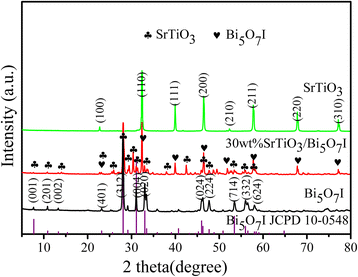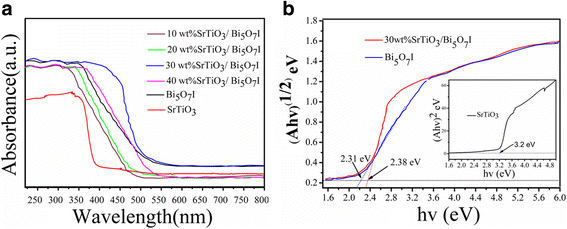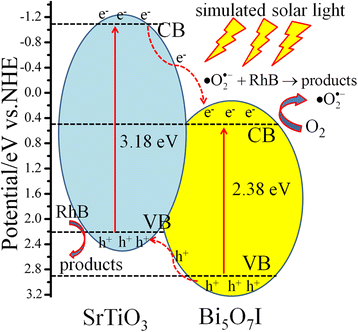Fabrication and Photocatalytic Property of Novel SrTiO3/Bi5O7I Nanocomposites
- PMID: 29752595
- PMCID: PMC5948192
- DOI: 10.1186/s11671-018-2558-6
Fabrication and Photocatalytic Property of Novel SrTiO3/Bi5O7I Nanocomposites
Abstract
The novel SrTiO3/Bi5O7I nanocomposites were successfully fabricated by a thermal decomposition approach. The as-prepared samples were characterized by XRD, XPS, SEM, EDS, FTIR, DRS and PL spectra. The results show that the SrTiO3/Bi5O7I nanocomposites are composed of perovskite SrTiO3 nanoparticles and tetragonal Bi5O7I nanorods. The SrTiO3/Bi5O7I nanocomposites exhibit an excellent photocatalytic performance for the degradation of RhB solution under simulated solar light irradiation, which is superior to that of pristine Bi5O7I and SrTiO3. In particular, the 30 wt% SrTiO3/Bi5O7I nanocomposite is found as the optimal composites, over which the dye degradation reaches 89.6% for 150 min of photocatalysis. The photocatalytic degradation rate of the 30 wt% SrTiO3/Bi5O7I nanocomposite is found to be 3.97 times and 12.5 times higher than that of bare Bi5O7I and SrTiO3, respectively. The reactive species trapping experiments suggest that [Formula: see text] and holes are the main active species responsible for the RhB degradation. In addition, the PL spectra elucidate the effective separation of photoinduced electron-hole pairs. Further, the possible photocatalytic mechanism of the SrTiO3/Bi5O7I nanocomposites is also elucidated based on the experimental evidences.
Keywords: Bi5O7I; Mechanism; Nanocomposite; Photocatalytic; SrTiO3.
Conflict of interest statement
Authors’ information
Zuming He is a professor and a Ph. D. degree holder specializing in the investigation of photocatalytic and nanometer materials. Yongmei Xia is an associate professor and a Ph. D. degree holder specializing in the investigation of photocatalytic and optical materials. Bin Tang is a professor and a Ph. D. degree holder specializing in the investigation of optical materials. Ya Liu is a professor and a Ph. D. degree holder specializing in the investigation of optical and nanometer materials. Jiangbin Su is a professor and a Ph. D. degree holder specializing in the nanofabrication and the electron beam-induced nanoinstability and nanoprocessing.
Competing interests
The authors declare that they have no competing interests.
Publisher’s Note
Springer Nature remains neutral with regard to jurisdictional claims in published maps and institutional affiliations.
Figures









References
-
- Raizada P, Singh P, Kumar A, Pare B, Jonnalagadda SB. Zero valent iron-brick grain nanocomposite for enhanced solar-Fenton removal of malachite green. Sep Purif Technol. 2014;133:429–437. doi: 10.1016/j.seppur.2014.07.012. - DOI
-
- Ye YC, Yang H, Li RS, Wang XX. Enhanced photocatalytic performance and mechanism of Ag-decorated LaFeO3 nanoparticles. J Sol-Gel Sci Technol. 2017;82:509–518. doi: 10.1007/s10971-017-4332-0. - DOI
-
- Singh P, Priya B, Shandilya P, Raizada P, Singh N, Pare B, Jonnalagadda SB (2016) Photocatalytic mineralization of antibiotics using 60%WO3/BiOCl stacked to graphene sand composite and chitosan. Arab J Chem. 10.1016/j.arabjc.2016.08.005
-
- Xia YM, Yu XQ, He ZM, Lu YL, Zhang YF, Sun SP, Zhu SQ, Li XP. Synthesis of novel copper-based oxide nanostructured film on copper via solution-immersion. Ceram Int. 2017;43:14499–14503. doi: 10.1016/j.ceramint.2017.07.091. - DOI
Grants and funding
LinkOut - more resources
Full Text Sources
Other Literature Sources

